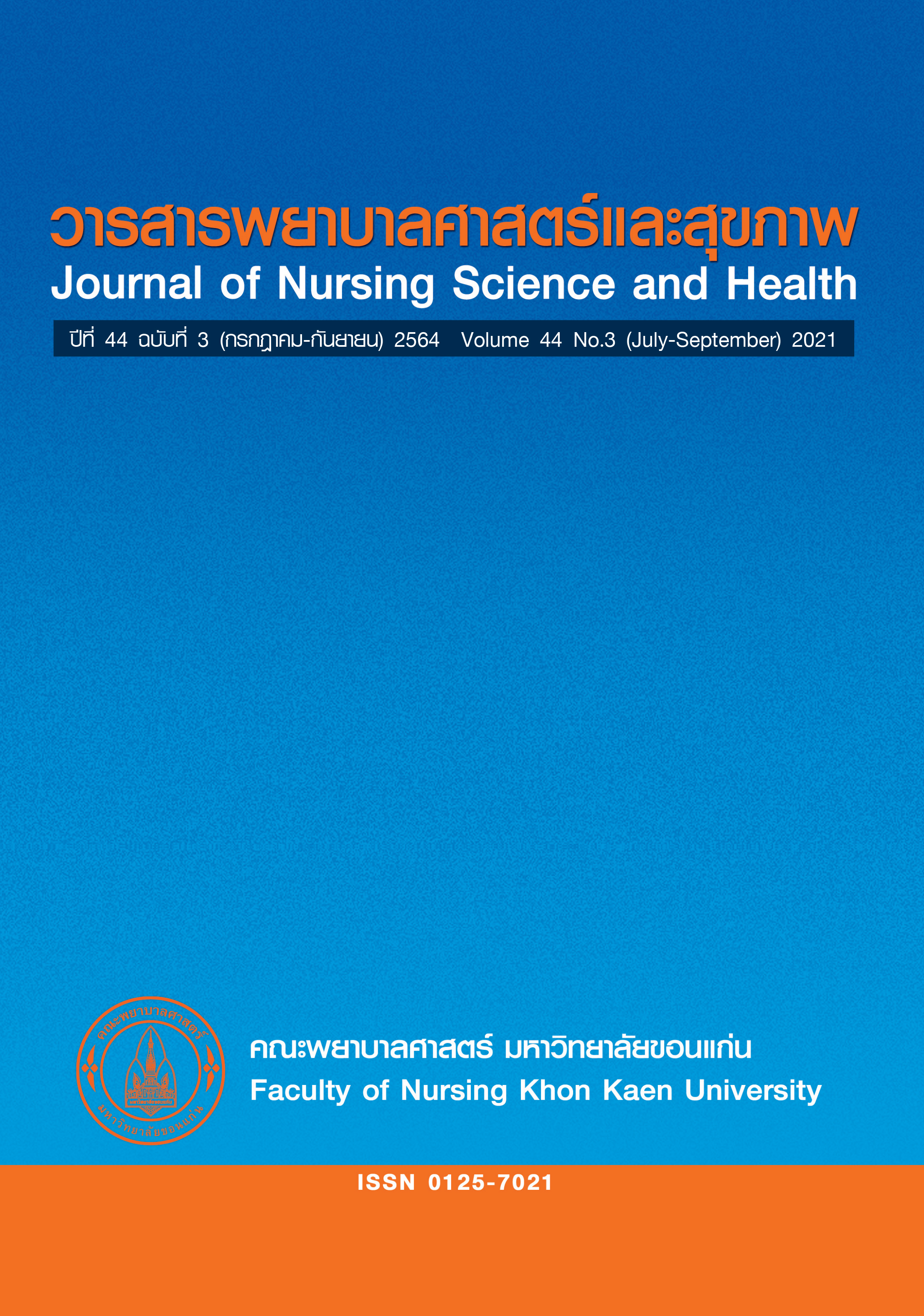แนวทางในการดูแลป้องกันท่อทางเดินหายใจเลื่อนหลุดในผู้ป่วยเด็กทารกระยะวิกฤต: การทบทวนวรรณกรรมอย่างเป็นระบบ
คำสำคัญ:
การป้องกัน, ท่อทางเดินหายใจเลื่อนหลุด, เด็กทารกระยะวิกฤตบทคัดย่อ
การทบทวนวรรณกรรมอย่างเป็นระบบในครั้งนี้ มีวัตถุประสงค์เพื่อสรุปแนวทางในการดูแลป้องกัน ท่อทางเดินหายใจเลื่อนหลุดในผู้ป่วยเด็กทารกระยะวิกฤต โดยการสืบค้นหลักฐานเชิงประจักษ์ทางการพยาบาล ที่ตีพิมพ์ระหว่างปี พ.ศ 2546 -2564 ได้หลักฐานเชิงประจักษ์ที่ผ่านเกณฑ์การคัดเลือกทั้งหมด 25 เรื่อง ประเมินคุณภาพงานวิจัยและสกัดข้อมูลโดยใช้แบบประเมินที่พัฒนาโดยสถาบันโจแอนนาบริกส์ ซึ่งแบ่งระดับของงานวิจัยได้ดังนี้ หลักฐานระดับ 2 จำนวน 16 เรื่อง ระดับ 3a จำนวน 1 เรื่อง ระดับ 3b จำนวน 3 เรื่อง ระดับ 3c จำนวน 5 เรื่อง และแบ่งระดับข้อเสนอแนะในการนำงานวิจัยไปใช้ ดังนี้ ระดับ A จำนวน 22 เรื่อง ระดับ B จำนวน 3 เรื่อง ผลการทบทวนพบว่า แนวทางในการดูแลป้องกันท่อทางเดินหายใจเลื่อนหลุดในผู้ป่วยเด็กทารกระยะวิกฤต ประกอบด้วย 1) ขั้นตอนการเตรียมผู้ป่วย เช่น การให้ข้อมูลกับญาติถึงความจำเป็นในการใส่ท่อทางเดินหายใจ การเลือกขนาดของท่อทางเดินหายใจที่เหมาะสม 2) การเฝ้าระวังภาวะเสี่ยงที่ส่งผลต่อท่อทางเดินหายใจเลื่อนหลุด ด้านผู้ป่วย เช่น มีน้ำลายมาก มีเสมหะมาก ไอขย้อน ผู้ป่วยดิ้น ส่ายศีรษะไปมา กระสับกระส่าย หรือมีความปวดจากการทำหัตถการ การผ่าตัด ด้านบุคลากรพยาบาลผู้ดูแลผู้ป่วยเด็กทารกมีความรู้และตระหนักในปัจจัยเสี่ยงที่ทำให้เกิดท่อทางเดินหายใจเลื่อนหลุด ด้านอุปกรณ์ เช่น พลาสเตอร์เหนียวยึดตรึงท่อทางเดินหายใจเปียก ลอก ท่อทางเดินหายใจดึงรั้ง น้ำในวงจรท่อทางเดินหายใจ ด้านเทคนิคการดูแล เช่น การตรวจสอบขนาดและความลึกของท่อทางเดินหายใจ การยึดติดท่อทางเดินหายใจ การจัดท่านอน การดูแลให้ได้รับยาระงับประสาท การผูกยึดข้อมือและการห่อตัวผู้ป่วย ด้านสิ่งแวดล้อม เช่น เสียงเตือน และ 3) การสื่อสารร่วมกับทีมแพทย์ ในการเตรียมถอดท่อทางเดินหายใจ สรุปได้ว่าแนวทางการพยาบาลที่ครอบคลุมปัจจัยเสี่ยงต่อการเกิดท่อทางเดินหายใจเลื่อนหลุด ร่วมกับการประยุกต์ใช้นวัตกรรมในการป้องกันท่อทางเดินหายใจเลื่อนหลุด และการประเมินความพร้อมในการถอดท่อทางเดินหายใจอยู่เสมอ สามารถช่วยลดอุบัติการณ์การเกิดท่อทางเดินหายใจเลื่อนหลุดได้
เอกสารอ้างอิง
Angkana J. The development of clinical nursing practice guideline for prevention of
accidental endotracheal tube extubation in neonate intensive care unit at Mahasarakham Hospital. [Dissertation]. KhonKean: KhonKean University; 2014. (in Thai)
Da Silva PSL, de Carvalho WB. Unplanned extubation in pediatric critically ill patients: A systematic review and best practice recommendations. Pediatr Crit Care Med 2010; 11(2): 287-94.
Jitra S. The development of clinical nursing practice guideline for prevention of accidental endotracheal tube extubation in pediatric intensive care unit at Photharam hospital. Journal of Nursing Division 2009; 40(2): 21-35. (in Thai)
Ketsara S. Critical nursing care for respiratory system. Songkla: Faculty of Nursing Prince of Songkla University; 2008. (in Thai)
Lockwood C, Porrit K, Munn Z, Rittenmeyer L, Salmond S, Bjerrum M, et, al. Chapter 2: Systematic reviews of qualitative evidence. In: Aromataris E, Munn Z. (Editors). Joanna Briggs Institute Reviewer’s Manual. The Joanna Briggs Institute, 2017. Available from: https://reviewersmanual. joannabriggs.org/
The Joanna Briggs Institute [JBl]. Joanna Briggs Institute Reviewer s’ Manual. 2014 edition. The Joanna Briggs Institute: Solito Fine Co; our Printers.
Predawan B. Benefit of nuchal arch and holder innovation for prevention of unplanned extubation in neonate [Dissertation]. Nakhon Pathom: Mahidol University; 2000. (in Thai)
Panthipha K. Happy bridge is a new innovation for securing endotracheal tubes in neonate. Sawanpracharak Medical Journal 2005; 2(3): 173-84. (in Thai)
Marcin JP, Rutan E, Rapetti P, BrownJ P, Rahnamay R, Pretzlaff RK. Nurse staffing and unplanned extubation in the pediatric intensive care unit. Pediat Criti Care Med 2005; 6(3): 254-7.
Temrutai M. Happy bridge and head lock pillow for prevention of unplanned extubation in neonate. Academic Conference of the Ministry of Public Health [Internet]; 2006 [cited 2018 Oct 12]. Available from https://sasukmsu.wordpress.com/2007/01/18. (in Thai)
Piyanan P. The effects of clinical nursing practice guideline for prevention of unplanned extubation in neonate intensive care unit at Loei hospita l[Dissertation]. Khon Kean: Khon Kean University; 2008. (in Thai)
Montha C, Wannee C, Ginda R, Rachada A. Translucent plastic splint to endotracheal tube for prevention of tube kinking and displacement in neonate. Thai Pediatric Journal 2008;1: 13-4. (in Thai)
DaSilva PSL, DeAguiar VE, Neb HM, DeCarvalho WB. Unplanned extubation in a pediatric intensive care unit: Impact of a quality improvement programe. Anaesthesia 2008; 3: 9-16.
Rachman BR, Watson R, Woods N, Mink RB. Reducing unplanned extubation in a pediatric intensive care unit: A systematic approach. Int J of Pediat 2009: 2009; 820495.
Yaowapa J. Development and implementation of clinical practice guidelines for unplanned endotracheal extubation in pediatric intensive care unit, Nakornping hospital, Chiang Mai province. Journal of Nurses Association of Thailand, North-Eastern Division 2009; 27(4): 22-9.
Patcharee T. The effects of clinical nursing practice guideline for assessment of risk factor for unplanned extubation and suitable practice in pediatric intensive care unit at Siriraj hospital [Internet]; 2011 [cited 2018 Oct 10]. Available from: http://hdl.handle.net /11228/3178. (in Thai)
Kaufman J, Rannie M, Kahn MG, Vitaska M, Wathen B, Peyton C, et al. An interdisciplinary initiative to reduce unplanned extubation in pediatric critical care units. Pediatrics 2012; 6: 1594-600.
Meregalli CN, Jorro Baron FA, D’Alessandro MA, Danzi EP, Debaisi GE. Impact of a quality improvement intervention on the incidence of unplanned extubations in a pediatric intensive careunit. Arch Argent pediatric 2013; 5: 391-7.
Thanaporn A, Pailin N, Patson K, Wilailak S. The development of clinical nursing practice guideline for prevention of accidental endotracheal tube extubation in pediatric intensive care unit at Sakonnakhon hospital. Journal of Sakonnakhon Hospital 2013; 2: 20-30. (in Thai)
Razavi SS, Nejad RA, Mohajerani SA, Talebian M. Risk factors of unplanned extubation in pedaitric intensive care unit. Tanaffos 2013; 12(3): 11-6.
Tassariya B. Benefit of the usage of T-model equipment for endotracheal tubes stabilization in neonate. Region 11 Medical Journal 2013; 7(3): 397-404. (in Thai)
Suwanya S. The effect of empowerment nursing practice guideline on preventing endotracheal tube displacement of newborn infant in neonatal intensive care unit at Mahasarakham hospital. Mahasarakham Hospital Journal 2015; 12: 169-81. (in Thai)
Fitzgerald RK, Davis AT, Hanson SJ. Multicenter analysis of the factors associated with unplanned extubation in the PICU. Pediatr Crit Care Med 2015; 16(7): e217-23.
Tripathi S, Nunez DJ, Katyal C, Ushay HM. Plan to have no unplanned: A collaborative hospital-based quality-improvement project to reduce the rate of unplanned extubations in the pediatric ICU. Respir Care 2015;60(8):1105-12.
Chisako M. Prevention strategies for unplanned extubation in NICU: A literature review. Journal of Neonatal Nursing 2016; 22: 91-102.
Rujira D, Duenpen T. The development of clinical nursing practice guideline for prevention of accidental endotracheal tube extubation in neonatal intensive care unit at Nakhonphanom hospital. Nakhonphanom Hospital journal 2016; 3(2): 57-66. (in Thai)
Pilailak K, Saranya J, Namtip K, Pakamas J. Prevention of unplanned extubation in pediatric intensive care unit. Princess of Naradhiwas University Journal 2020; 12(1): 25-35. (in Thai)
Valeria CN, Camila GR, Bruno M, Elessandra B, Adriana K, Monica C, et al. Effectiveness of a bundle to prevent unplanned extubation in a pediatric intensive care unit: A multidisciplinary approach. Pediatric Dimensions 2020; 5: 1-5.
ดาวน์โหลด
เผยแพร่แล้ว
รูปแบบการอ้างอิง
ฉบับ
ประเภทบทความ
สัญญาอนุญาต
วารสารพยาบาลศาสตร์และสุขภาพเป็นเจ้าของลิขสิทธิ์ในการเผยแพร่ผลงานที่ตีพิมพ์ห้ามผู้ใดนำบทความที่ได้รับการตีพิมพ์ในวารสารพยาบาลศาสตร์และสุขภาพไปเผยแพร่ในลักษณะต่าง ๆ ดังนี้ การนำบทความไปเผยแพร่ออนไลน์ การถ่ายเอกสารบทความเพื่อกิจกรรมที่ไม่ใช่การเรียนการสอน การส่งบทความไปตีพิมพ์เผยแพร่ที่อื่น ยกเว้นเสียแต่ได้รับอนุญาตจากวารสารพยาบาลศาสตร์และสุขภาพ



